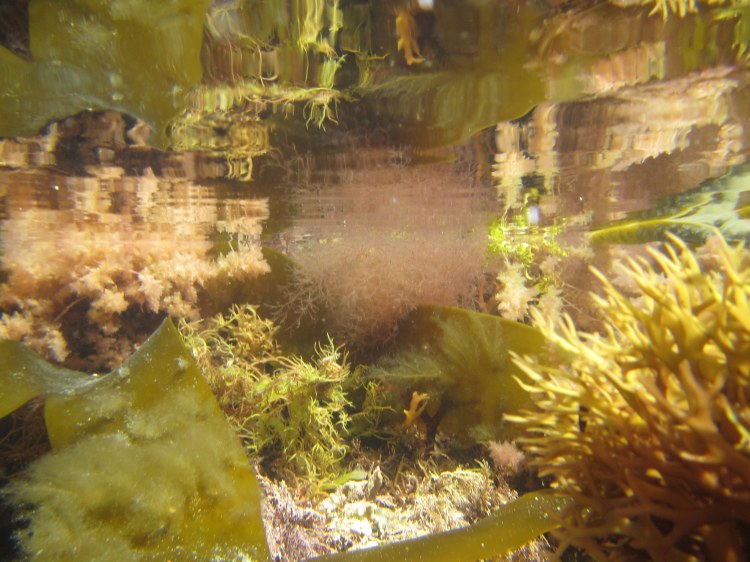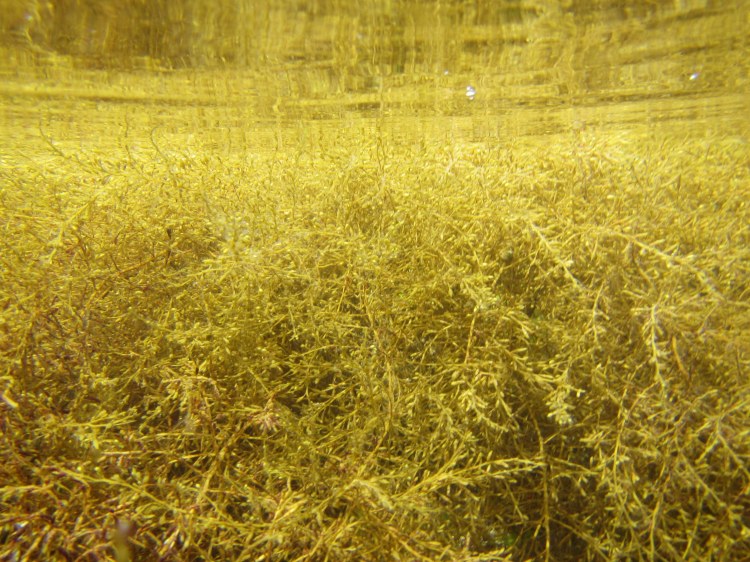 Last week it was time to check the state of the seaweeds and as expected they looked glorious. Unfortunately it was a bit windy and choppy and so the viz left something to be desired, argh! These are some of the better pics. I am in the process of creating a gallery of seaweed species (just reds to begin with), see the link at the very top of the blog. This is by no means a proper guide, as for that you often need more detail than just underwater impressions, but extra images might help in conjuction with a proper guide such as the “Seaweeds of Britain and Ireland” Seasearch book. Anyway, I have started gathering old pics and hope to add more soon. The common flat red species in the photos above and below is very pretty but it is one of these species you need to look at under the microscope so I will not attempt to label it with a name (yet). Other species can be identified more easily, such as Under tngue weed Hypoglossum hypoglossoides (two photos below).
Last week it was time to check the state of the seaweeds and as expected they looked glorious. Unfortunately it was a bit windy and choppy and so the viz left something to be desired, argh! These are some of the better pics. I am in the process of creating a gallery of seaweed species (just reds to begin with), see the link at the very top of the blog. This is by no means a proper guide, as for that you often need more detail than just underwater impressions, but extra images might help in conjuction with a proper guide such as the “Seaweeds of Britain and Ireland” Seasearch book. Anyway, I have started gathering old pics and hope to add more soon. The common flat red species in the photos above and below is very pretty but it is one of these species you need to look at under the microscope so I will not attempt to label it with a name (yet). Other species can be identified more easily, such as Under tngue weed Hypoglossum hypoglossoides (two photos below).

 Below, Thong Weed Himanthalia elongata, Little Fat Sausage Weed Champia parvula and Juicy Whorl Weed Chylocladia verticillata and a bit of Bushy rainbow wrack Cystoseira tamariscifolia covered in red epiphytes.
Below, Thong Weed Himanthalia elongata, Little Fat Sausage Weed Champia parvula and Juicy Whorl Weed Chylocladia verticillata and a bit of Bushy rainbow wrack Cystoseira tamariscifolia covered in red epiphytes.
Tag Archives: Hypoglossum hypoglossoides
Falmouth Seaweeds October
 To my regret I did not manage to take a look at the seaweeds at Castle Beach in September (it was my aim to go in at least once every month). Last Friday however, the sun was shining, the wind was gone and the tide was low (and I was able to escape work) so I at least could make October. Not only was the viz excellent, to my surprise, the seaweeds looked very healthy. It seems that there is a second, autumn seaweed bloom that I was not aware of. Some of the bleached corraline algae have regained their pink colour, the Harpoon weed Asparagopsis armata increased in abundance and I saw species such as Red grape weed Gastroclonium ovatum growing again. The Bushy rainbow wrack has partly died back, forming dense, dark-brown mats (fourth photo) but also show fresh growth. This species is covered in many epiphytes such as Brown fan weed Dictyota dichotoma, and remnants of Bull huss mermaid’s purses still cling on. Interestingly, Wireweed Sargassum muticum has almost completely disappeared.
To my regret I did not manage to take a look at the seaweeds at Castle Beach in September (it was my aim to go in at least once every month). Last Friday however, the sun was shining, the wind was gone and the tide was low (and I was able to escape work) so I at least could make October. Not only was the viz excellent, to my surprise, the seaweeds looked very healthy. It seems that there is a second, autumn seaweed bloom that I was not aware of. Some of the bleached corraline algae have regained their pink colour, the Harpoon weed Asparagopsis armata increased in abundance and I saw species such as Red grape weed Gastroclonium ovatum growing again. The Bushy rainbow wrack has partly died back, forming dense, dark-brown mats (fourth photo) but also show fresh growth. This species is covered in many epiphytes such as Brown fan weed Dictyota dichotoma, and remnants of Bull huss mermaid’s purses still cling on. Interestingly, Wireweed Sargassum muticum has almost completely disappeared. 
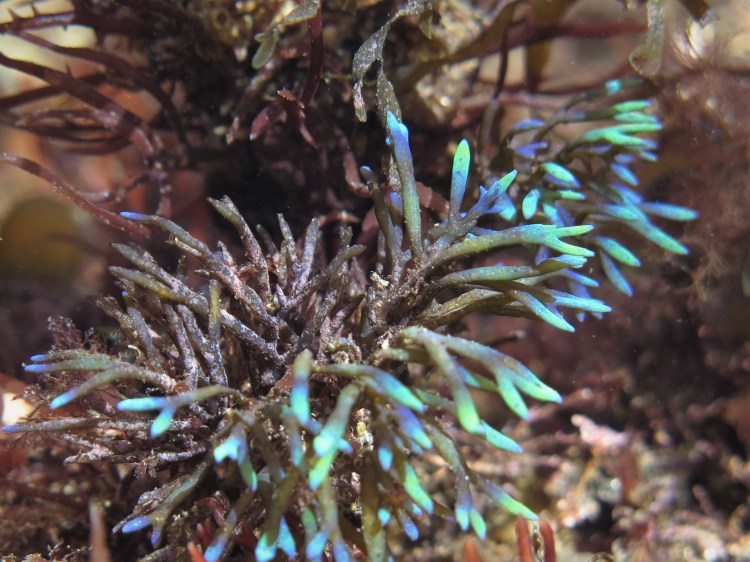
 It is tricky photographing rock pool seaweeds. One main issue is to not disturb any sediment, especially as I keep it *very* shallow, sometimes lying on my stomach (I definitely do not need fins). The other main issue with using a (wide angle) wetlens is that there are three glass surfaces in front of the lens collecting bubbles and so need regular wiping. Light is also a challenge: photographing against the sun causes glare, but having the sun in your back results in casting shadows over your subject. I continuously fiddle with the exposure correction, but it remains difficult with the white sand and pebbles around the seaweeds. Below, some healthy looking Solier’s string weed Soliera chordalis, two photos of an ‘unknown’, Norwegian fan weed Gymnogrongus crenulatus, Under-tongue weed Hypoglossum hypoglossoides, seaweeds starting to grow on a pebble, and a rock covered in a variety of seaweeds.
It is tricky photographing rock pool seaweeds. One main issue is to not disturb any sediment, especially as I keep it *very* shallow, sometimes lying on my stomach (I definitely do not need fins). The other main issue with using a (wide angle) wetlens is that there are three glass surfaces in front of the lens collecting bubbles and so need regular wiping. Light is also a challenge: photographing against the sun causes glare, but having the sun in your back results in casting shadows over your subject. I continuously fiddle with the exposure correction, but it remains difficult with the white sand and pebbles around the seaweeds. Below, some healthy looking Solier’s string weed Soliera chordalis, two photos of an ‘unknown’, Norwegian fan weed Gymnogrongus crenulatus, Under-tongue weed Hypoglossum hypoglossoides, seaweeds starting to grow on a pebble, and a rock covered in a variety of seaweeds.
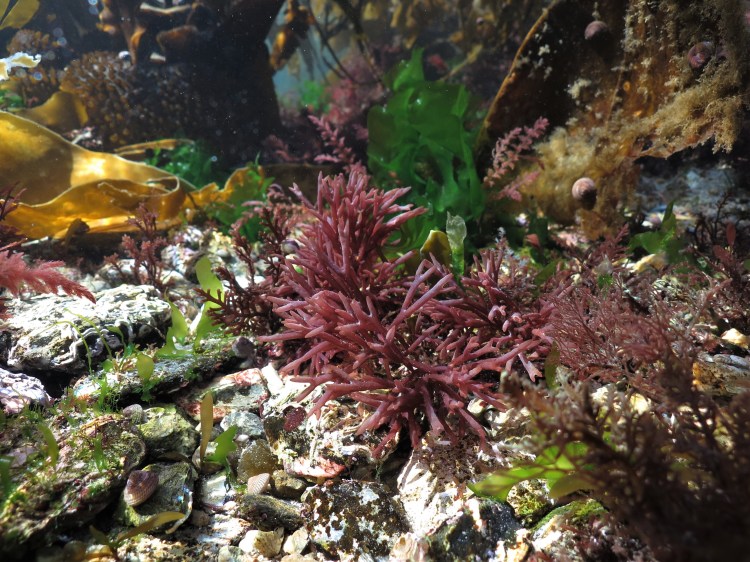
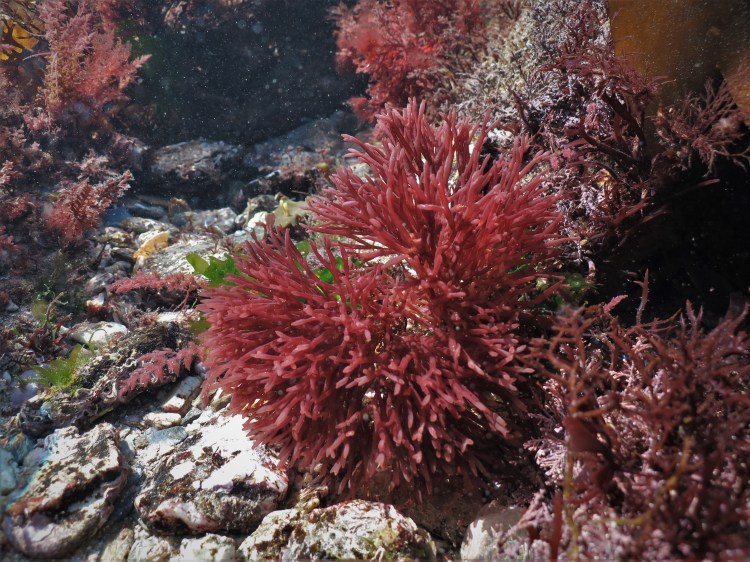

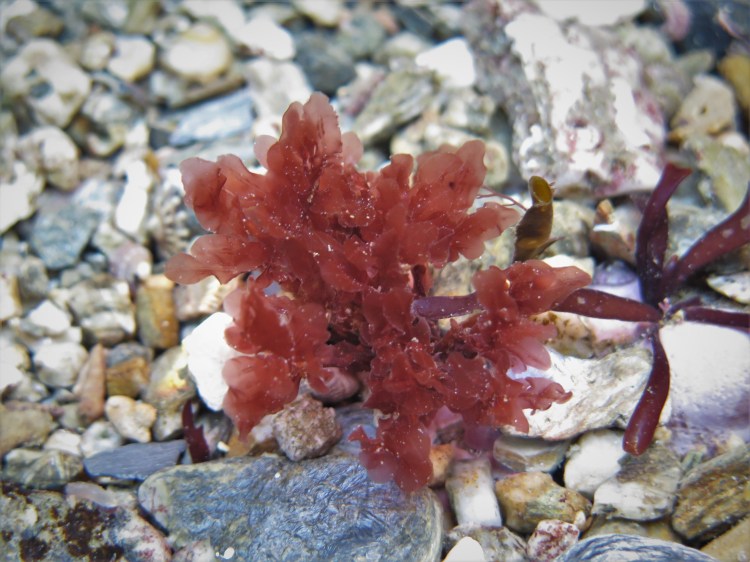

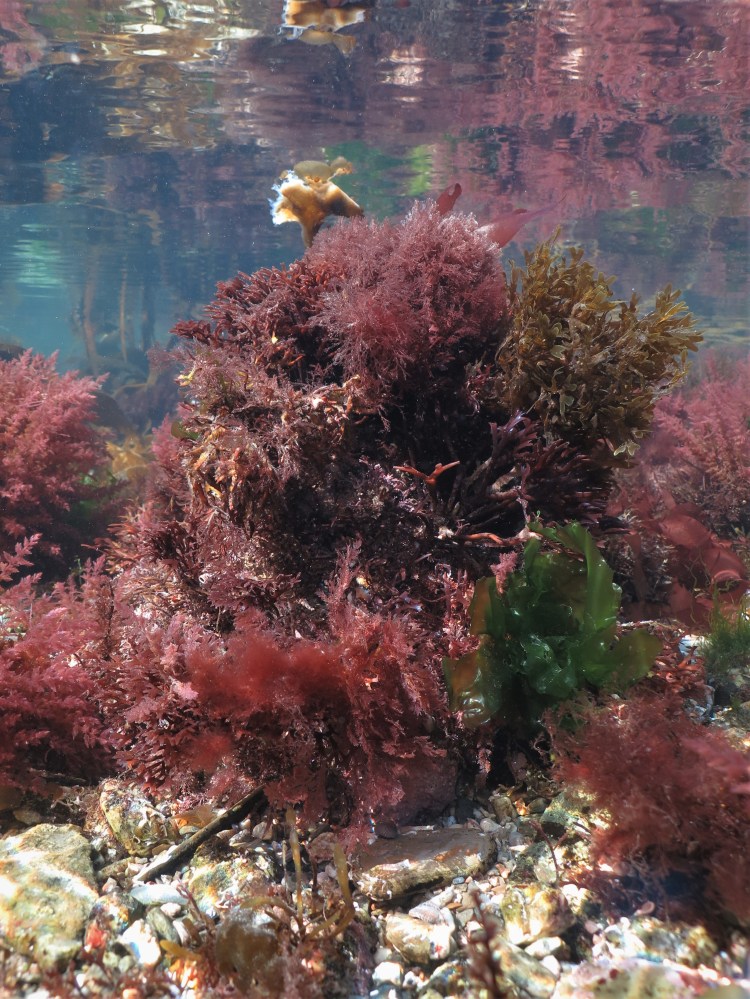
Falmouth Seaweeds: Mid-March part 2
 More seaweed photos, taken a couple of days after the ones in the previous post, when it was overcast and the water was less clear. The photos are not as good, but there are still a lot of interesting species to see. Below some photos showing the diversity of species next and on top of each other. In the last two months, most species have been growing quite a lot. There are quite large patches of Slender-beaded coral weed Jania rubens. Bushy rainbow wrack Cystoseira tamariscifolia plants are completely overgrown with all kinds of epiphytes, seaweeds, sponges and colonial tunicates, and often have a Nursehound egg case attached.
More seaweed photos, taken a couple of days after the ones in the previous post, when it was overcast and the water was less clear. The photos are not as good, but there are still a lot of interesting species to see. Below some photos showing the diversity of species next and on top of each other. In the last two months, most species have been growing quite a lot. There are quite large patches of Slender-beaded coral weed Jania rubens. Bushy rainbow wrack Cystoseira tamariscifolia plants are completely overgrown with all kinds of epiphytes, seaweeds, sponges and colonial tunicates, and often have a Nursehound egg case attached. 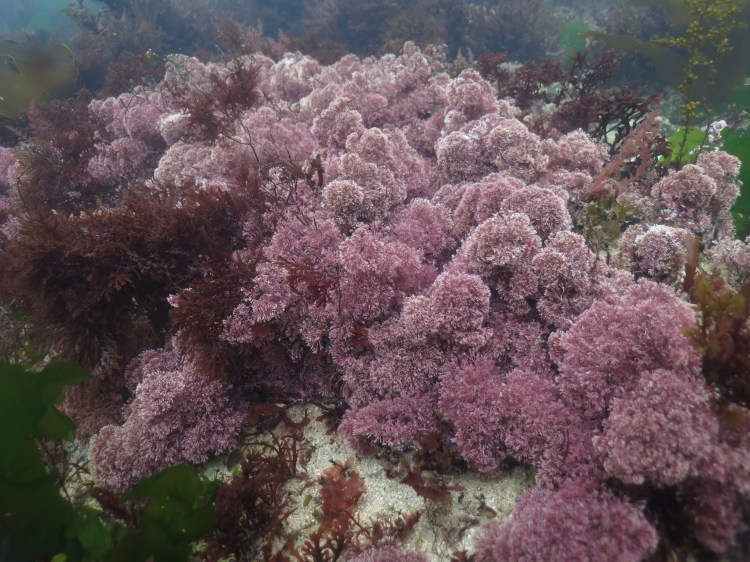
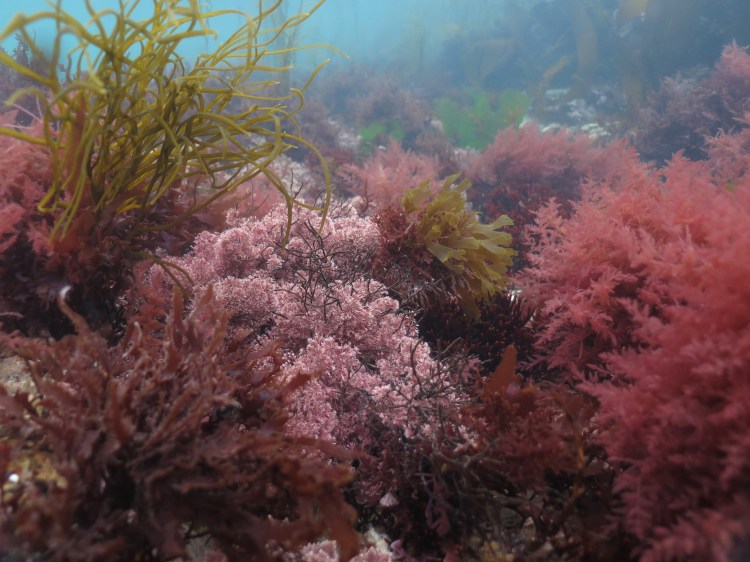



 Next, photos of individual species. First some flat reds: Leafy rose weed Rhodophyllis divaricata, Beautiful fan weed Callophyllis laciniata, Branched hidden ribs Cryptopleura ramosa (probably), the invasive species Devil’s tongue weed Grateloupia turuturu and Under tongue weed Hypoglossum hypoglossoides. After that, two species that look a bit similar: left the reddish Discoid fork weed Polyides rotundus and right Clawed fork weed Furcellaria lumbricalis. The former is one of the most common species (also on the photo above it) but difficult to photograph as it usually sits on the white sand. After that, Juicy whorl weed Chylocladia verticillata. Last, two quite unassuming species: Black scour weed Ahnfeltia plicata and Sea flax weed Stypocaulon scoparium. Identifications made possible using the must-have Seasearch Guide to Seaweeds of Britain and Ireland, David Fenwick’s excellent aphotomarine website (and personal communication) and the good people of the Seaweeds of the NE Atlantic facebook group (any mistakes are my own).
Next, photos of individual species. First some flat reds: Leafy rose weed Rhodophyllis divaricata, Beautiful fan weed Callophyllis laciniata, Branched hidden ribs Cryptopleura ramosa (probably), the invasive species Devil’s tongue weed Grateloupia turuturu and Under tongue weed Hypoglossum hypoglossoides. After that, two species that look a bit similar: left the reddish Discoid fork weed Polyides rotundus and right Clawed fork weed Furcellaria lumbricalis. The former is one of the most common species (also on the photo above it) but difficult to photograph as it usually sits on the white sand. After that, Juicy whorl weed Chylocladia verticillata. Last, two quite unassuming species: Black scour weed Ahnfeltia plicata and Sea flax weed Stypocaulon scoparium. Identifications made possible using the must-have Seasearch Guide to Seaweeds of Britain and Ireland, David Fenwick’s excellent aphotomarine website (and personal communication) and the good people of the Seaweeds of the NE Atlantic facebook group (any mistakes are my own). 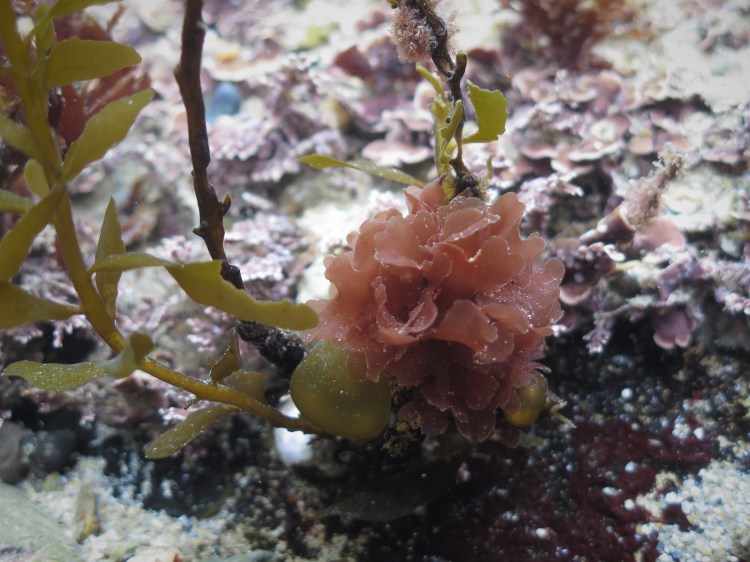



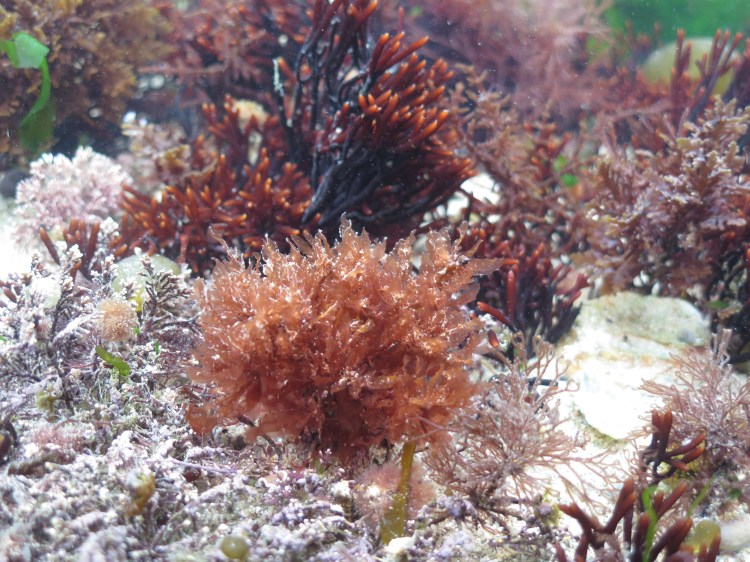


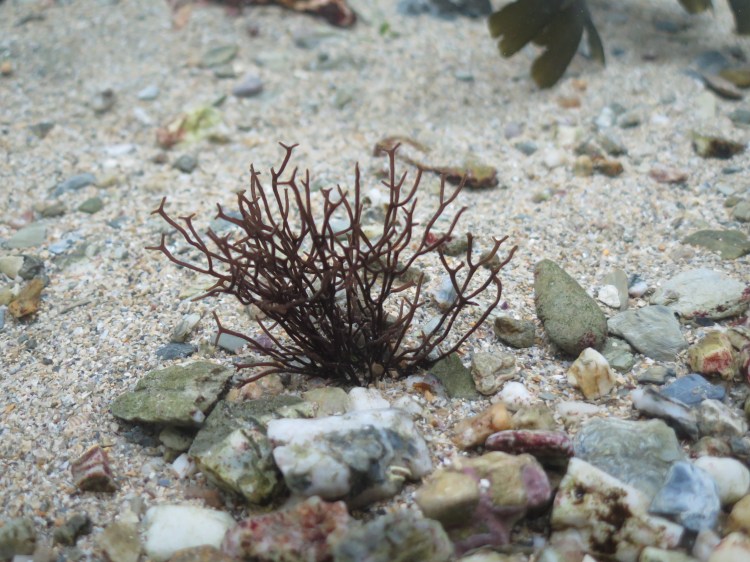

Falmouth Seaweeds: January
 As I noticed that the rock pools have started to look really pretty, I have gone out snorkelling four times the last week to photograph seaweeds. Bitterly cold (around 10°C) but worth it! It is my aim to post photo’s taken at the same spot every month this year, let’s see. The first three days the tide was very low, making it more of a lying on the sand rather than actual snorkelling. The sun was out and my main challenge was to get to grips with overexposure, checking histograms and decreasing image brightness. The other main challenge is to not stir the sand up and create ‘marine snow’. It makes a world of difference to actually stick your head underwater and look through the viewfinder instead of lazily only submerging the camera. For now, I have only cropped and adjusted contrast of jpegs using Picasa, but I have also shot in raw format and hope to get more out of the shots in the near future. With help from the excellent Seasearch Guide to Seaweeds of Britain and Ireland and the Seaweeds of the NE Atlantic facebook page some of the species could be identified.
As I noticed that the rock pools have started to look really pretty, I have gone out snorkelling four times the last week to photograph seaweeds. Bitterly cold (around 10°C) but worth it! It is my aim to post photo’s taken at the same spot every month this year, let’s see. The first three days the tide was very low, making it more of a lying on the sand rather than actual snorkelling. The sun was out and my main challenge was to get to grips with overexposure, checking histograms and decreasing image brightness. The other main challenge is to not stir the sand up and create ‘marine snow’. It makes a world of difference to actually stick your head underwater and look through the viewfinder instead of lazily only submerging the camera. For now, I have only cropped and adjusted contrast of jpegs using Picasa, but I have also shot in raw format and hope to get more out of the shots in the near future. With help from the excellent Seasearch Guide to Seaweeds of Britain and Ireland and the Seaweeds of the NE Atlantic facebook page some of the species could be identified. 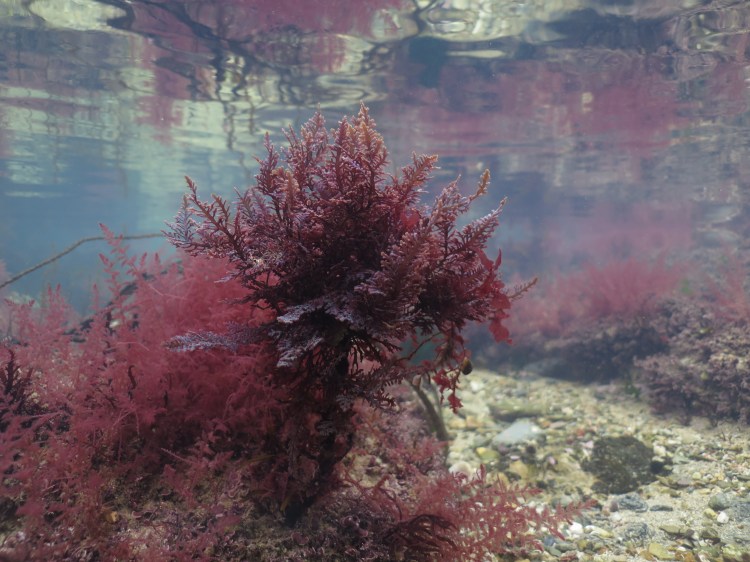
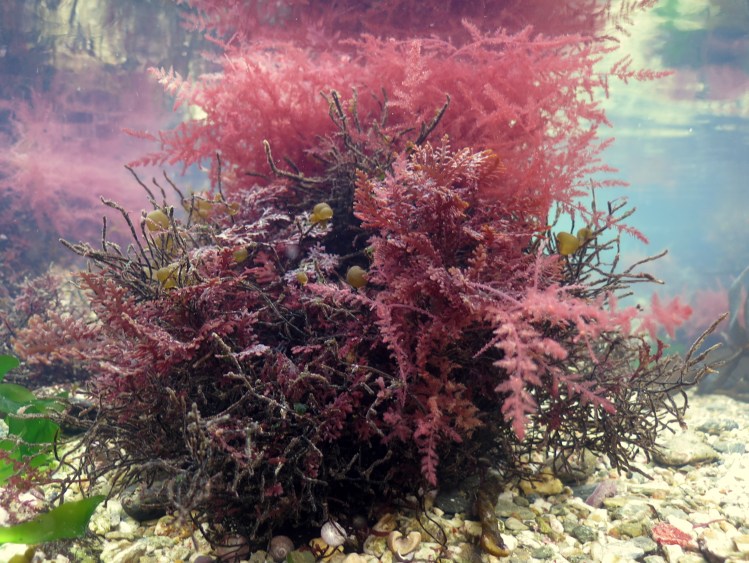
 Above, Osmundea osmunda (probably), which has a very nice blueish (‘glaucus’) tinge (I need to take some close-ups of that next time). In the following photo, a whole tangle of species, mainly Hairy sand weed Cladostephus spongiosus, with Osmundea, Asparagopsis, Bonnemaisonia and Leathesia. Next, another picture of a whole variety of species, I would like to find out what the red epiphyte is. Below some photos of individual species of red seaweeds (mostly not great but it gives an idea of the diversity). First, Leafy rose weed Rhodophyllis divaricata, next Falkenbergia (which is actually not a species but a distinct phase in the life cycle of Harpoonweed Asparagopsis Armata), Berry wart cress Sphaerococcus coronopifolius, Irish moss Chondrus crispus, Beautiful fan weed Callophyllis laciniata, Under tongue weed Hypoglossum hypoglossoides, Chondrus with Falkenbergia and Hypoglossum and Plocamium on top and a small unknown species. You can see that most photos suffer from overexposure (and notice my crude upped contrasts).
Above, Osmundea osmunda (probably), which has a very nice blueish (‘glaucus’) tinge (I need to take some close-ups of that next time). In the following photo, a whole tangle of species, mainly Hairy sand weed Cladostephus spongiosus, with Osmundea, Asparagopsis, Bonnemaisonia and Leathesia. Next, another picture of a whole variety of species, I would like to find out what the red epiphyte is. Below some photos of individual species of red seaweeds (mostly not great but it gives an idea of the diversity). First, Leafy rose weed Rhodophyllis divaricata, next Falkenbergia (which is actually not a species but a distinct phase in the life cycle of Harpoonweed Asparagopsis Armata), Berry wart cress Sphaerococcus coronopifolius, Irish moss Chondrus crispus, Beautiful fan weed Callophyllis laciniata, Under tongue weed Hypoglossum hypoglossoides, Chondrus with Falkenbergia and Hypoglossum and Plocamium on top and a small unknown species. You can see that most photos suffer from overexposure (and notice my crude upped contrasts).
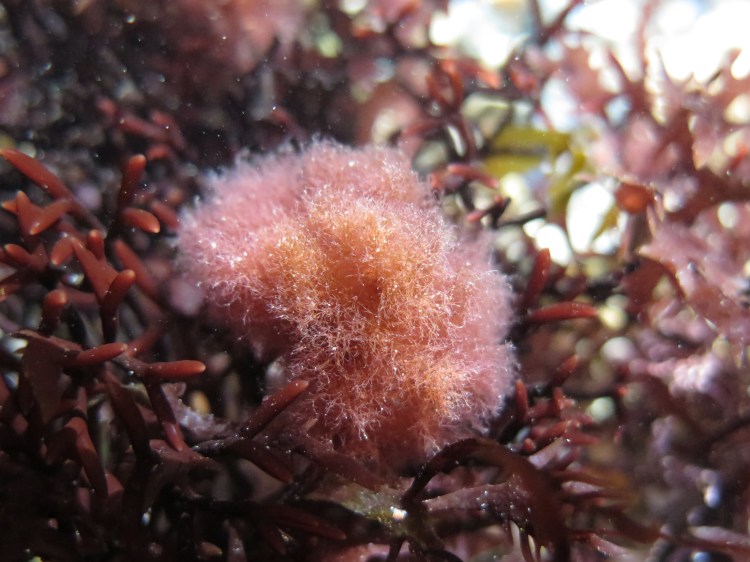




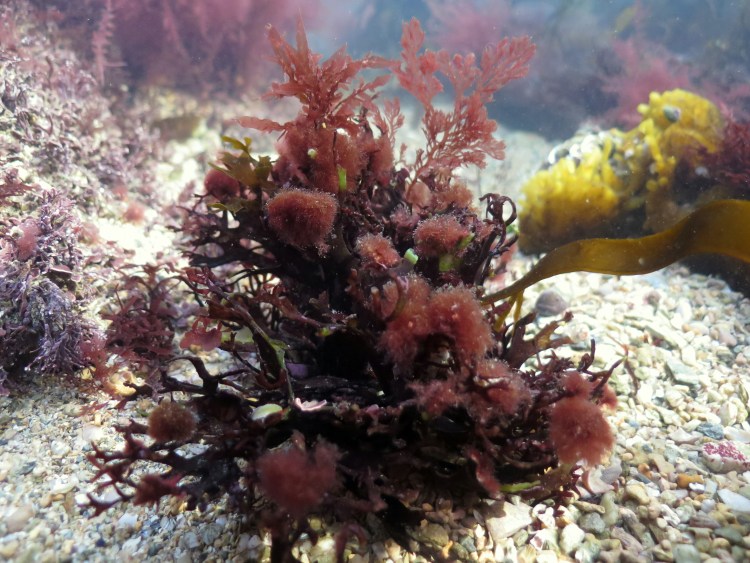
 The last time I went snorkelling, it was overcast and the tide was higher. I tried a bunch of shots a greater distance away to capture more of an overall impression, but with more water between the subject and the lens the shots become ‘milky’. The next shot of a whole variety of red, green and brown species (with Clawed fork weed Furcellaria lumbricalis in the middle) could have been really nice with clearer water, better framing and correct exposure! The next shot shows Cladostephus and Thong weed Himanthalia elongata on top of a rock covered with Red grape weed Gastroclonium ovatum (also on the last photo).
The last time I went snorkelling, it was overcast and the tide was higher. I tried a bunch of shots a greater distance away to capture more of an overall impression, but with more water between the subject and the lens the shots become ‘milky’. The next shot of a whole variety of red, green and brown species (with Clawed fork weed Furcellaria lumbricalis in the middle) could have been really nice with clearer water, better framing and correct exposure! The next shot shows Cladostephus and Thong weed Himanthalia elongata on top of a rock covered with Red grape weed Gastroclonium ovatum (also on the last photo). 

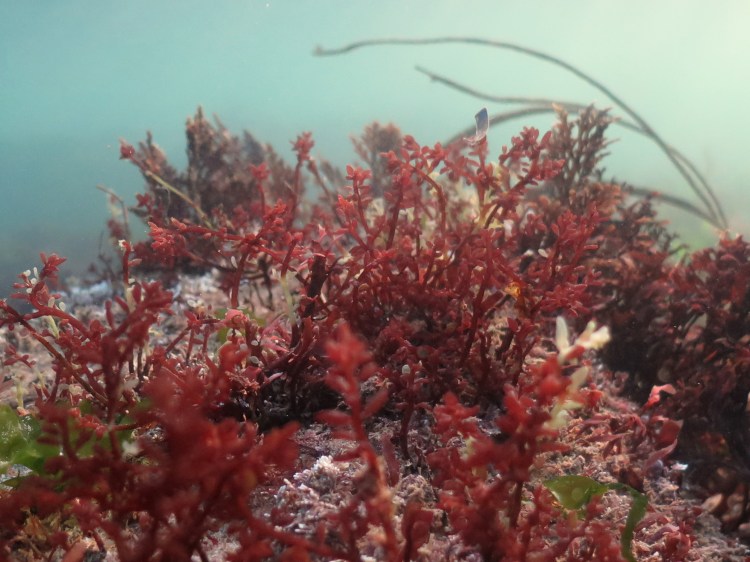
Leftover Pics
When going out rock pooling, I always take my iPhone and Canon Powershot (for underwater use) and take at least a couple of photos. Because of a lack of time, or because a single good photo is not enough for a new post, not everything ends up on the blog. Now I have some free time, I picked a couple of unused photos made this year that seem blog-worthy. First up, In realized only what I had found on the beach at St. Ives when leafing through the The Essential Guide to Beachcombing and the Strandline: a Seabeard! This hydroid, Nemertesia antennina, grows as stiff colonies protruding from a matted base and occasionally washes up on shore. It looks a bit plant-like; at the time I did not have the opportunity to have a closer look and just snapped a quick photo. Next a Lesser sandeel Ammodytes tobianus found at Gylly beach. I always see them when snorkeling or diving (see here) but this was a good opportunity to see one up close (I get excited when I spot a dead fish on the beach (see also here) and I am not afraid to admit it!). 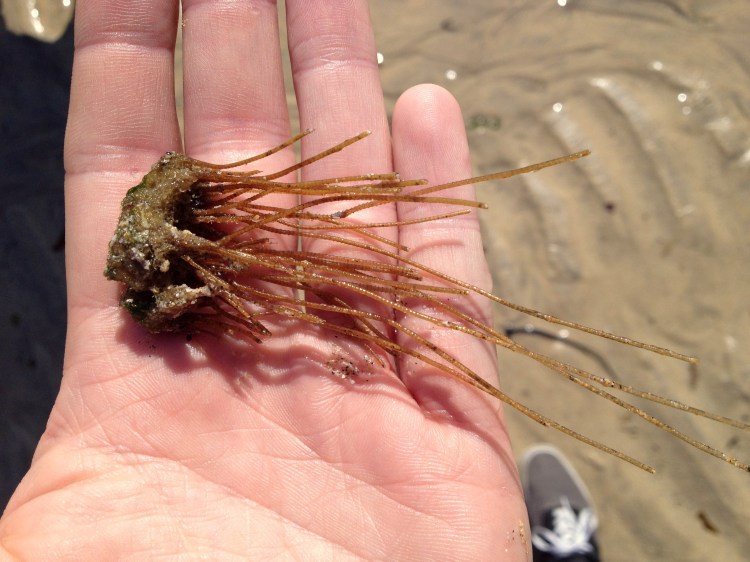

 Following are two colour varieties of the Spiny starfish Marthasterias glacialis, a Common brittlestar Ophiothrix fragilis and a shot of an Aequorea forskalea (or maybe A. vitrina) jellyfish. Next the gastropod mollusc Chinaman’s hat Calyptraea chinensis. I went back to Mylor marina for some pontooning recently but not much was growing; the only thing that stood out was the luxuriant sponge growth (I am not sure of the species, perhaps Halichondria).
Following are two colour varieties of the Spiny starfish Marthasterias glacialis, a Common brittlestar Ophiothrix fragilis and a shot of an Aequorea forskalea (or maybe A. vitrina) jellyfish. Next the gastropod mollusc Chinaman’s hat Calyptraea chinensis. I went back to Mylor marina for some pontooning recently but not much was growing; the only thing that stood out was the luxuriant sponge growth (I am not sure of the species, perhaps Halichondria).
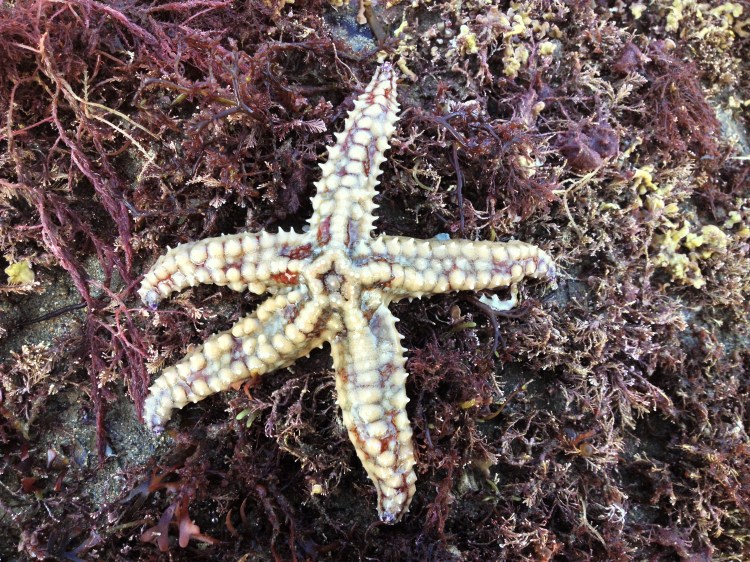



 And of course some seaweed pictures. By iPhone: Under tongue weed Hypoglossum hypoglossoides in Flushing, Black scour weed Ahnfeltia plicata in St. Agnes and a photo showing a variety of wracks all colonizing the same patch (Flushing): Serrated wrack Fucus serratus, Spiraled wrack Fucus spiralis, Bladderwrack Fucus vesiculosis and Egg wrack Ascophylum nodosum. Next some Canon Powershot underwater pics (see also this post and this one): a random rock pool picture of mostly decaying seaweed, a closeup of my favourite the Bushy rainbow wrack Cystoseira tamariscifolia and a shot of Wireweed Sargassum muticum that has completely taken over a pool. Finally an SLR photo of a rock pool at Gylly beach with large Cystoseira baccata plants (middle, Wireweed on the left).
And of course some seaweed pictures. By iPhone: Under tongue weed Hypoglossum hypoglossoides in Flushing, Black scour weed Ahnfeltia plicata in St. Agnes and a photo showing a variety of wracks all colonizing the same patch (Flushing): Serrated wrack Fucus serratus, Spiraled wrack Fucus spiralis, Bladderwrack Fucus vesiculosis and Egg wrack Ascophylum nodosum. Next some Canon Powershot underwater pics (see also this post and this one): a random rock pool picture of mostly decaying seaweed, a closeup of my favourite the Bushy rainbow wrack Cystoseira tamariscifolia and a shot of Wireweed Sargassum muticum that has completely taken over a pool. Finally an SLR photo of a rock pool at Gylly beach with large Cystoseira baccata plants (middle, Wireweed on the left).


